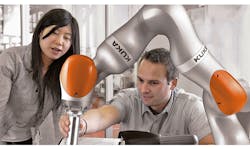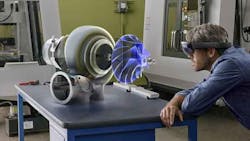The fourth industrial revolution, also called Industry 4.0., is driving digital transformation across smart factories – blending computing power with machine and sensor technologies. And 5G, or the 5th generation mobile network, will supercharge this transformation. 5G will bring faster speeds, lower latency, large bandwidth, and edge computing capabilities.
Imagine a more agile, fully connected, and automated manufacturing experience from design to distribution with unprecedented levels of machine learning and AI: 5G is helping us speed toward this reality.
While 4G boosted broadband speeds for things like streaming video on mobile devices, 5G will handle the influx of connected devices worldwide.
AT&T plans to introduce mobile 5G technology in parts of a dozen U.S. cities by the end of 2018. With that in mind, here’s a look at five ways 5G is expected to ultimately help power the smart factory of the future.
Massive Industrial IoT
According to a recent study by (IDC)i, the manufacturing and transportation industries yearly spend more on IoT is more than other industries. And the manufacturing industry will continue to spend more yearly on IoT than any other industry through 2022.
To manage the large amount of data and information from these connected devices, manufacturing companies will need 5G capacity and speeds. From procurement to distribution, 5G will mean manufacturers can connect more sensors, devices, and assets through a single network giving them better visibility into the supply chain. The possibilities for these connected devices are nearly endless. For example, these connected devices could help improve predictive maintenance and operational efficiency on the factory floor as well as prevent theft and quality issues within logistics channels.
Robotics
5G will be the catalyst that will eventually help unleash the capabilities of robotics. Because 5G will utilize edge computing capabilities, data will live closer to the source. This combined with the high speeds and large bandwidth of 5G will kick-start the creation of smaller, cheaper, and untethered robots.
Auto manufacturing is already using co-bots, or collaborative robots, to complete hard-to-reach, dangerous tasks underneath the car while human workers perform tasks outside the car. 5G will eventually help these robots become more agile, making faster decisions and quickly adjusting to changes in near real time.
Ultimately, we will see more types of smaller autonomous and collaborative robots on the factory floor performing a variety of tasks. These robots will not only help take the load off their human co-workers but will ultimately help factories optimize production.
Flexible Networking
5G will help enable manufacturing companies to be more flexible and adjust the network based on their needs. With on-premise edge computing capabilities, they will be able to control sensitive data locally. In addition, they will be able to eventually separate a single physical 5G network into multiple virtual networks via network slicing. For instance, a portion of the network in a manufacturing plant could be split off for operational equipment efficiency or when there’s an increase in market demand.
These capabilities coupled with network functions virtualization (NFV) and software-defined networking (SDN) will be among the key ingredients for manufacturers to optimize their networks for ideal performance.
Augmented Reality and Virtual Reality
Manufacturing companies are already using augmented and virtual reality. However, they haven’t fully invested in the technologies because of the large bandwidth it takes to run them. Employees also must be physically connected to the network to use the technologies.
With 5G, employees will be able to work with the technologies anywhere on the factory floor. They will be able to use it for activities like training, machine maintenance, data visualization, and designing. Better bandwidth will mean less probability that AR/VR connections are lost or that the technology will have to compete for connections. Imagine every employee having an AR headset that lets them adjust the production of a machine without touching it. Or visualize machine maintenance instructions on the fly.
AI and Machine Learning
AI will be a key feature of the smart factory of the future, but it needs access to large amounts of near real-time, quality data to work efficiently. 5G’s massive IoT connections and fast speeds, combined with edge computing power, will eventually enable AI to quickly “learn” from its mistakes and make smarter, faster, and more reliable decisions.
Currently, AI is used in small doses to complete repetitive tasks. Eventually, AI could be used to control factory floor production with little to no intervention from humans. But AI won’t just be used to control machines, it could also be used to predict issues in the supply chain, prevent fraud, and assess production opportunities.
The 5G smart factory of the future will center on a fully connected experience. From massive device connectivity and innovative technology experiences to near real-time automation and network flexibility, 5G will help bring major advancements to the smart factory. Manufacturing companies could ultimately realize major benefits such as performance improvements, operational efficiencies, and increased safety.
















